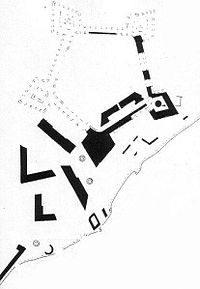Real Cittadella
| Real Cittadella | |
|---|---|
| Part of the fortifications of Messina | |
| Messina, Sicily, Italy | |

View of Messina before the earthquake of 1783, with the Cittadella in the foreground
|
|

Map of the Cittadella, with the surviving parts in black
|
|
| Coordinates | 38°11′16″N 15°34′0.6″E / 38.18778°N 15.566833°E |
| Type | Star fort |
| Site information | |
| Condition | Two bastions, some curtain walls and outworks intact |
| Site history | |
| Built | 1680–1686 |
| Built by | Spanish Empire |
| In use | 1680s–20th century |
| Materials | Limestone |
| Fate | Partially demolished |
| Battles/wars |
War of the Quadruple Alliance War of the Polish Succession Sicilian revolution of 1848 Expedition of the Thousand World War II |
The Real Cittadella was a star fort in Messina, Sicily. The Cittadella was built between 1680 and 1686 by the Spanish Empire, and it was considered to be one of the most important fortifications in the Mediterranean. Most of the fort was demolished in the 20th century, but some parts can still be seen.
The Real Cittadella was built by the Spanish Empire (who controlled the Kingdom of Sicily) between 1680 and 1686. It was built to defend the port of Messina, but it was also meant to establish a strong garrison in the city to prevent the population from revolting, as had happened a few years earlier in 1674.
The fort was designed by Carlos de Grunenbergh, the military engineer of the Viceroy of Sicily. It was built in the centre of the peninsula of San Raineri, and was cut off from the mainland by a moat. The extremity of the peninsula was occupied by the Forte del Santissimo Salvatore.
A neighborhood populated by 8000 people, a Benedictine monastery and several churches had to be demolished to make way for the construction of the Cittadella.
The Spanish lost control of Sicily to the House of Savoy in 1713. In 1718, they invaded the island during the War of the Quadruple Alliance, and the Cittadella surrendered to the Spanish general Spinola. A year later it was recaptured by the Austrian Count Claude Florimond de Mercy. The Cittadella was again captured by the Bourbon Charles III of Spain in 1735, during the War of the Polish Succession.
The fort was also used as a prison, and the French geologist Déodat Gratet de Dolomieu was imprisoned there in 1798.
...
Wikipedia
